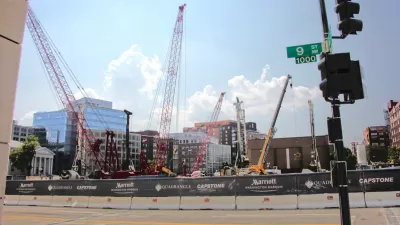A look back at Washington, D.C.'s most recent Comprehensive Plan reveals lessons for how the city should plan for the future next time it undertakes a comprehensive planning process.

The Greater Greater Washington site is undertaking a roundtable, of sorts, to review Washington, D.C.'s 2005 Comprehensive Plan. Each week, Greater Greater Washington readers are discussing the section and summarizing their discussion on the site.
David Whitehead summarizes the most recent discussion, which centered on the comp plan's priority on enabling an inclusive city.
DC's 2005 Comprehensive Plan began with a strong and encouraging vision: building a growing and inclusive city. Just one chapter later, it lists a set of contradictory guiding principles that waffle between preserving the status quo and promoting inclusive growth. Oops.
To back that argument, Whitehead digs into the plan's section on the guiding principles for growth. Readers notices that many of the guiding principles employ contradictory terms—antonyms even.
Corey Holman noticed that many of these statements use "near antonyms," like "Maintaining and enhancing the mix of housing types" (Principle #3) or "ensure that neighborhood character is preserved and enhanced" (Principle #8). He wrote, "How can something be maintained or preserved while also being enhanced? It's that wishy-washy language that allows people to see what they want in this document, instead of laying out a clear vision.
The lesson of the post is that next time around, the District will require a comp plan that makes strong statements about its principles—especially since the District is growing much faster than the 2005 plan anticipated.
FULL STORY: 33 pages after calling for a growing and inclusive city, DC's Comprehensive Plan muddies that vision

Planetizen Federal Action Tracker
A weekly monitor of how Trump’s orders and actions are impacting planners and planning in America.

San Francisco's School District Spent $105M To Build Affordable Housing for Teachers — And That's Just the Beginning
SFUSD joins a growing list of school districts using their land holdings to address housing affordability challenges faced by their own employees.

The Tiny, Adorable $7,000 Car Turning Japan Onto EVs
The single seat Mibot charges from a regular plug as quickly as an iPad, and is about half the price of an average EV.

With Protected Lanes, 460% More People Commute by Bike
For those needing more ammo, more data proving what we already knew is here.

In More Metros Than You’d Think, Suburbs are Now More Expensive Than the City
If you're moving to the burbs to save on square footage, data shows you should think again.

The States Losing Rural Delivery Rooms at an Alarming Pace
In some states, as few as 9% of rural hospitals still deliver babies. As a result, rising pre-term births, no adequate pre-term care and "harrowing" close calls are a growing reality.
Urban Design for Planners 1: Software Tools
This six-course series explores essential urban design concepts using open source software and equips planners with the tools they need to participate fully in the urban design process.
Planning for Universal Design
Learn the tools for implementing Universal Design in planning regulations.
Smith Gee Studio
City of Charlotte
City of Camden Redevelopment Agency
City of Astoria
Transportation Research & Education Center (TREC) at Portland State University
US High Speed Rail Association
City of Camden Redevelopment Agency
Municipality of Princeton (NJ)





























